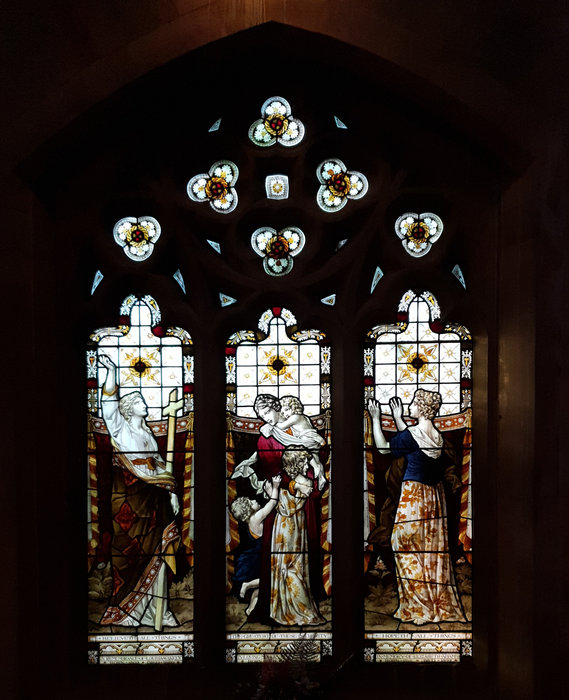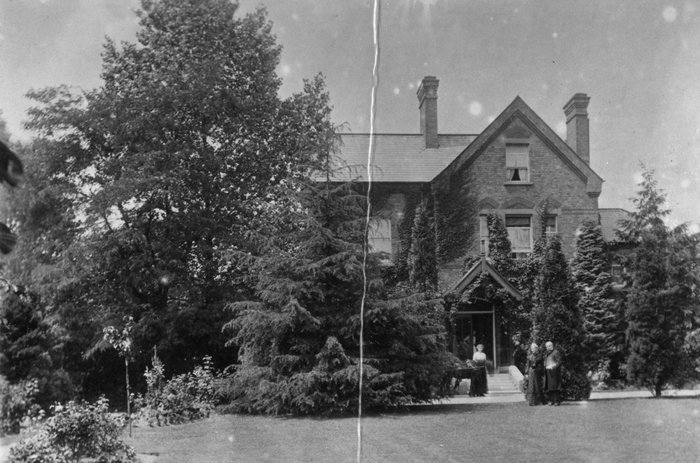This article by Stephen Gilburt was first published by the Enfield Society in newsletter 225, Spring 2022.

Henry Storer Toms
[Courtesy of Enfield Local Studies & Archive]
Henry Storer Toms 1840–1916 was educated at University College School and London University. He trained for the ministry at New College, St John’s Wood. He was the second son of Joseph Toms of Woodbury in Clay Hill, Enfield. (Joseph Toms founded Derry and Toms department store in South Kensington.) Storer Toms was ordained and inducted at Chase Side Chapel on 31st October 1865. As part of his early ministry he preached a series of sermons on Chase Green about the need for the Gospel. He was also an active supporter of the Liberal Party and campaigned to establish a School Board for Enfield.
By the late 1860’s there were good relations between the members of the adjoining Zion and Chase Side Chapels. A friendship had developed between John Stribling, minister of Zion Chapel since 1832, and Storer Toms. By 1871, John Stribling’s health was failing and it was proposed to unite the two chapels. 49 out of 58 members of Zion Chapel supported the proposal and at Chase Side Chapel the vote was unanimous. A joint meeting also unanimously voted to call Storer Toms to the pastorate of the united church, which it was later decided to call Christ Church Congregational Church.

Sketches of the exterior and interior of the proposed new Christ Church
[Courtesy of Enfield Local Studies & Archive]
Neither building was large enough for the combined congregation including the Sunday School established in 1832. An acre of land behind Zion Chapel, known as “Stray Field” was purchased to allow a larger church to be built on the site of Zion Chapel. This would be able to seat 780 adults, all at ground level. A manse for the minister and his family was planned to be added later. Chase Side Chapel was to be converted into a lecture hall and school room.

Left: Lecture Hall (demolished 1963) and Christ Church in 1900, Right: Interior of the Church about 1900
[Courtesy of Enfield Local Studies & Archive]
The foundation stone of the Grade II listed Christ Church was laid on 29th June 1874. Designed by John Tarring, it was built in the Gothic Decorated style by Cooke and Green at a cost of nearly £11,000. It has a brick core faced with Kentish Ragstone, with Bath stone dressings around the doors and windows outside and is faced with Bath stone inside. Children were asked to go into the surrounding fields and collect leaves, flowers and fruit which were incorporated into the designs for the capitals at the top of the columns. The church was com-pleted when Storer Toms climbed the scaffolding to place the weather vane in position on top of the 180 feet high spire. The church was dedicated on Thursday 18th November 1875.

[Courtesy of Christ Church URC]
On the west wall of the apse is a carved stone relief of Jesus’s Last Supper based on Leonardo da Vinci’s painting in Milan. It was given by the builders Cooke and Green.

[Courtesy of Christ Church URC]
The pulpit, designed by F. G. Anstey, was constructed of Caen Stone and alabaster. The pulpit, communion table and chairs, organ screen and transept windows with floral designs were given to the church by Joseph Toms. The reading desk was given by Dr. John James Ridge, a deacon of Christ Church for 33 years. The three manual organ with pneumatic action had great, swell and choir organs.

[Courtesy of Christ Church URC]
Most of the stained glass windows date from around 1890 and were given in memory of various church members. On the apse wall are windows showing Jesus Christ as the Good Shepherd holding a sheep and as the Saviour of the World carrying a cross.

[Courtesy of Christ Church URC]
In the south aisle is an 1892 window by Ward and Hughes, a London firm of stained glass makers, who also produced windows for Jesus Church, Forty Hill. From the left are Faith (or belief) holding a cross, Charity (or love) looking after children and Hope holding up her arms to heaven.
In the north aisle are windows showing Philip, Stephen the first Christian martyr, and Parmenas, who were three of the seven first century deacons.
On the east wall of the nave are windows showing the four gospel writers—*Matthew, Mark, Luke and John. Each is holding a pen, scroll or book to indicate that he wrote one of the gospels. Between them are Peter, holding the key to the Kingdom of Heaven and Paul with a sword, the emblem of his martyrdom.

Manse about 1900
[Courtesy of Enfield Local Studies & Archive]
In 1885 a Church Parlour, for social and business meetings, a Ladies Vestry, a larger Deacons Vestry, toilets and a kitchen were added to the south-west corner of the church. (The Church Parlour and Ladies Vestry were demolished in 1995 to provide access to a care home, now a medical day centre, built at the same time behind the church on the site of the former Manse.)

Caroline Toms and her daughters taking tea in the Manse garden in the early 1900s
[Courtesy of Enfield Local Studies & Archive]
From 1865 Reverend Storer Toms and his family lived at Poplars, 87 Chase Side (see newsletter 223 Autumn 2021) until in 1887 a manse was constructed behind the church. The 1891 census records the following residents—Storer Toms 51, his wife Caroline 50, children: Florence 23, Henry 21, Norris 19, Christina 17, Edgar 15, Maud 13, Constance 11, Elsie 9 and servants: Hannah 22, the cook and Nellie 16, the housemaid.
By 1900 there were about 450 members of the congregation. The music at the 11am and 6.30pm Sunday services was led by the organist and choir. In addition a Wednesday service was held at 8pm in the Church Parlour. The afternoon Sunday School and Bible Classes had over 700 children and young people, many of whom took part in an annual Scripture Examination organised by the Sunday School Union.
The 3rd Enfield Company of the Boys Brigade was founded in 1890 by Norris Toms. In the early days officers and boys in uniform were sometimes pelted with bottles and other missiles as they walked to drill nights. The Boys Brigade was criticised by some people who believed that the boys were being trained to fight for their country rather than become soldiers for Christ. The ladies in the Dorcas Society made items for sale at the annual Church bazaar.
There were also three groups dedicated to abstinence from alcohol—Band of Hope, Total Abstinence Society and Abstinence Guild. Among other organisations associated with the church were a Young Ladies Society, a Men’s Institute and “a Young Men’s Guild which has a Guildhall open all week in which some 200 young men find amusement and instruction.” [Mackenzie MacBride 1902]. The Christ Church Provident Society, founded by Florence Toms to encourage savings, had an annual income of over £800.
Members of Christ Church were also involved in providing education at the British School and later at Chase Side School, in campaigning to establish a School Board for Enfield, in improving healthcare and promoting temperance in Enfield and in establishing Christ Church Hall Mission (which is now Lancaster Road United Reformed Church). These subjects will be covered in two future editions of Enfield Society News.
In 1905 Reverend Henry Storer Toms retired after a ministry of 40 years and moved to Barnet, where he died in 1916.
A fuller history of Zion Chapel, Chase Side Chapel and Christ Church from 1780 to 2022 may be found in Christ Church (now a United Reformed Church) newsletters from January 2021. These are available online at ccurc.org.uk. A bibliography used in the preparation of this article may be found on our web-site. Some of the publications may be consulted at Enfield Local Studies Library and Archive.

South side of Christ Church 2019
[Courtesy of Christ Church URC]
Bibliography of Congregationalism in Enfield
Various church record books, minister registers, accounts, magazines and newsletters for Zion Chapel, Chase Side Chapel and Christ Church since 1780.
Chase Side Congregational Record Bazaar Number July 1873.
History of Christ Church Enfield by Mackenzie MacBride 1902
History of Christ Church Enfield by J.S. Stribling 1917.
Christ Church Magazine, September 1918
Christ Church Quarterly Vol. 1 No.1 November 1928
The Christ Church Monthly Volume VIII No. 7 July 1939
Christ Church Newsletter 1947-2022
Nonconformist Churches in Enfield by Geoffrey Knight EHHS 1973
History of Christ Church Enfield by Fred J. Gould and John R. Day 1975
Enfield School Board by Sylvia Collicott EHHS 1985
Bush Hill Park United Reformed Church 1887-1987 by the Elders, B.H.P. U.R.C. 1987
We the Music Makers (celebrating 50 years of Christ Church/Enfield Choral Society) 1988
A History of Enfield by David Pam EPS Volume 1 (before 1839) 1990, Volume 2 (1837-1914) 1992, Volume 3 (1914-1939) 1994.
A History of Winchmore Hill United Reformed Church 1742-1991 by Ramsbotham, Williams and Woolveridge 1991
Enfield Past by Graham Dalling 1999
Ponders End United Reformed Church. A short history by Peter Cowley 2006
The Enfield Book by Graham Dalling 2007
Lancaster Road United Reformed Church 1885-2010 by Revd. Roy Eames, Jim Holliday and others 2010.
History of the 3rd Enfield Company of the Boys Brigade by Robert Wilson 2019. www.3rdenfieldbb.co.uk
Guide to Christ Church URC Enfield (with information on the stained glass windows, organ and memorials) by Stephen Gilburt 2019.
History of Christ Church United Reformed Church Enfield by Stephen Gilburt 2021
Christ Church URC website www.ccurc.org.uk
Westminster College Cambridge for information on Cheshunt College.




